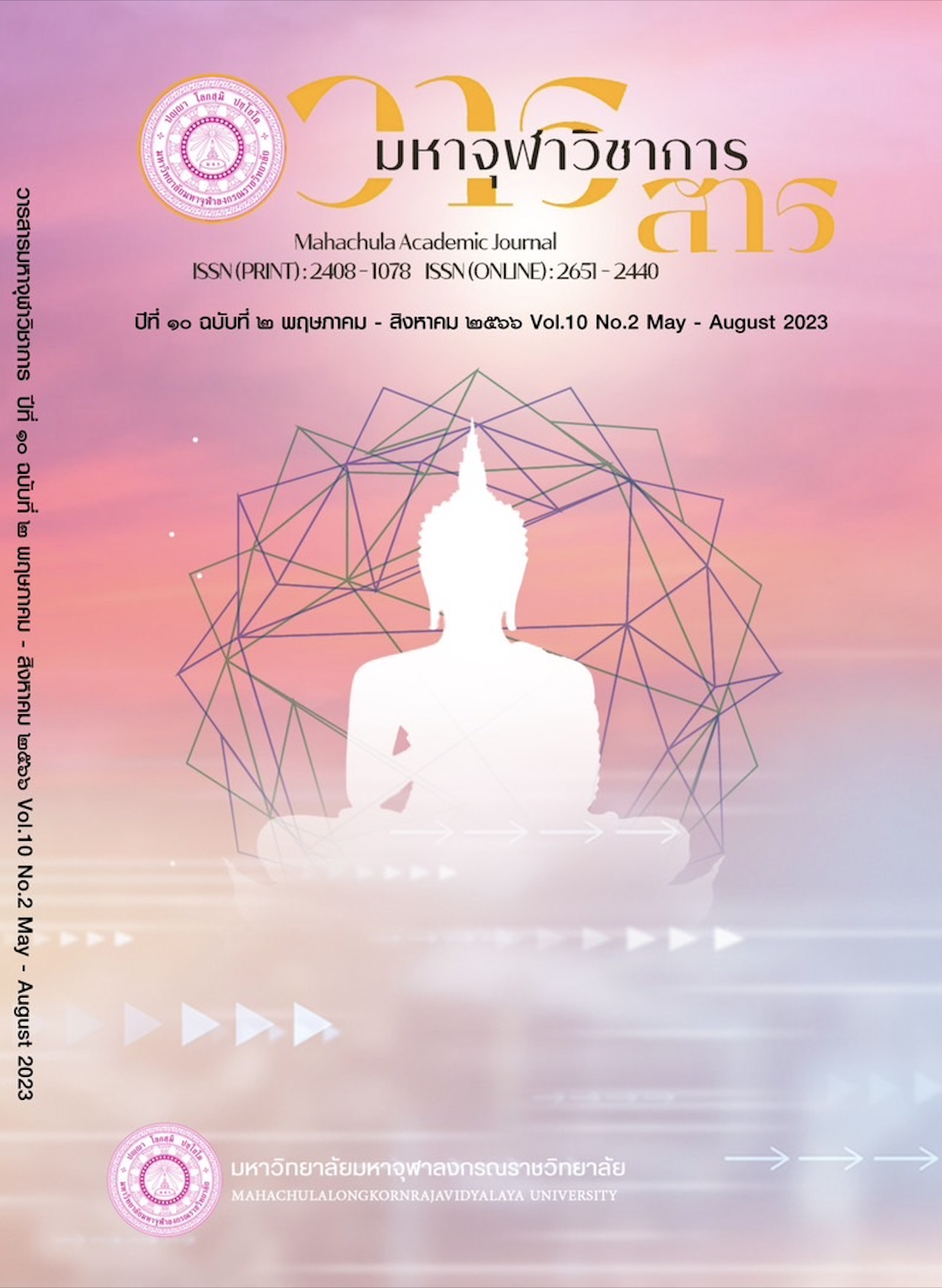Mind Development in Tebhūmikathā
Main Article Content
Abstract
This research entitled “Mind Development in Tebhūmikathā” has three objectives: (1) to study the background and structure in Tebhūmikathā; (2) to explore the explanation of mind appearing in Tebhūmikathā; and (3) to propose a guideline for mental development in Te Bhumikatha. The study applied a documentary research methodology. From the study, it is found that Tebhūmikathā or ‘the Exposition of Three Realms’ is a literary work written by King Lithai in B.E. 1888 with the intention of expounding the Dhamma for his mother as a way of showing his gratitude to her and teaching the Abhidhamma as well. Its structure is divided into eleven chapters: (1) a realm of the hell beings; (2) a realm of the animals; (3) a realm of the suffering ghosts; (4) a realm of the demons; (5) a realm of human beings; (6) a realm of six devas; (7) a realm of sixteen formal deities or brahmas; (8) a realm of four formless deities or brahmas; (9) Avinibhogarupa; (10) destruction and renewal of the world; and (11) discourse on Nibbāna.
It is believed that Tebhūmikathā aims at investigating consciousness accompanied by equanimity (upekkha-santīraṇacitta) as one of unwholesome resultant consciousness (akusalavipākacitta) can lead beings to be reborn in the planes of loss and woe (apāya-bhūmi); investigating consciousness accompanied by equanimity (upekkha-santīraṇacitta) as one of wholesome-resultant rootless consciousness (kusalavipāka-ahetukacitta) can lead beings to be reborn in the realms of handicapped human beings and deities; eight kinds of sense-sphere resultant consciousness (kāmāvacara-vipākacittaor mahāvipākacitta) can lead beings to be reborn in the realms of human beings and deities; five kinds of fine-material-sphere resultant consciousness (rūpāvacara-vipākacitta) can lead beings to be born as brahma in material sphere (rūpā-bhrama); four kinds of immaterial-sphere resultant consciousness (arūpāvacara-vipākacitta) can lead beings to be born as brahma in immaterial sphere (arūpā-bhrama). In Tebhūmikathā, there are four types of guideline for mind development: (1) mind development at the level of sensual pleasure (kāmāvacara) done through the ten wholesome courses of action (kusalakammapatha) in order to be reborn as human being or deity, (2) mind development at the level of rūpajhānacitta in order to be reborn in rūpa-brahma (brahma in material sphere), (3) mind development at the level of arūpajhānacitta in order to be reborn in Brahma in immaterial sphere (arūpa-brahma), and (4) mind development at the level of Supramundane (lokuttara) through mental development and insight meditation.
Article Details

This work is licensed under a Creative Commons Attribution-NonCommercial-NoDerivatives 4.0 International License.
References
กัลยกร ทองโสม. “ไตรภูมิพระร่วง: วิถีธรรม วิถีชีวิต”. วารสารบัณฑิตวิทยาลัยมหามกุฏ. ปีที่ ๑๘ ฉบับ
ที่ ๑๘ (กรกฎาคม-ธันวาคม ๒๕๖๓) : ๑๖๒
นิยะดา เหล่าสุนทร. ไตรภูมิพระร่วง การศึกษาที่มา. กรุงเทพมหานคร: สำนักพิมพ์แม่คำผาง, ๒๕๔๓.
นวลวรรณ พูนวสุพลฉัตร และคณะ. “การศึกษาปัจจัยที่มีอิทธิพลต่อการพระราชนิพนธ์เรื่องไตรภูมิพระร่วง”. รายงานวิจัย. สถาบันวิจัยพุทธศาสตร์: มหาวิทยาลัยมหาจุฬาลงกรณราชวิทยาลัย, ๒๕๖๓.
พระมหาสมบูรณ์ วุฑฒิกโร. “จิตตมาตรของนิกายโยคาจาร: การศึกษาเชิงวิเคราะห์บนฐานแนวคิดเรื่องจิตในพระพุทธศาสนายุคต้น”. ดุษฎีนิพนธ์พุทธศาสตรดุษฎีบัณฑิต สาขาวิชาพระพุทธศาสนา. บัณฑิตวิทยาลัย: มหาวิทยาลัยมหาจุฬาลงกรณราชวิทยาลัย, ๒๕๕๐.
พระพรหมคุณาภรณ์ (ป. อ. ปยุตฺโต). พจนานุกรมพุทธศาสตร์ ฉบับประมวลธรรม. พิมพ์ครั้งที่ ๓๖. กรุงเทพมหานคร: สำนักพิมพ์ผลิธัมม์, ๒๕๕๙.
มหาจุฬาลงกรณราชวิทยาลัย. พระไตรปิฎกภาษาไทย ฉบับมหาจุฬาลงกรณราชวิทยาลัย. กรุงเทพมหานคร: โรงพิมพ์มหาจุฬาลงกรณราชวิทยาลัย, ๒๕๓๙.
มหาจุฬาลงกรณราชวิทยาลัย. อรรถกถาภาษาไทย พระสุตตันตปิฎก ขุททกนิกาย ธรรมบท ภาค ๒. กรุงเทพมหานคร: โรงพิมพ์มหาจุฬาลงกรณราชวิทยาลัย, ๒๕๕๖.
มหาจุฬาลงกรณราชวิทยาลัย. อรรถกถาภาษาไทย พระอภิธรรมปิฎก ธรรมสังคณีปกรณ์. กรุงเทพมหานคร: โรงพิมพ์มหาจุฬาลงกรณราชวิทยาลัย, ๒๕๕๖.
แม่ชีกฤษณา รักษาโฉม. “ศึกษาวิเคราะห์แนวคิดเรื่องจิตในคัมภีร์พระพุทธศาสนาเถรวาท”. วารสารสันติศึกษาปริทรรศน์ มจร. ปีที่ ๘ ฉบับที่ ๔ (กรกฎาคม - สิงหาคม ๒๕๖๓) : ๑๒๓๔.
ราชบัณฑิตยสถาน. พจนานุกรมศัพท์วรรณคดีไทย สมัยสุโขทัย ไตรภูมิกถา. กรุงเทพมหานคร: ราชบัณฑิตยสถาน, ๒๕๔๔.
วิญญู กินะเสน และบุญชนา วิวิธขร. “ศึกษาวิเคราะห์มนุษย์กับการปกครองในวรรณกรรมไตรภูมิพระร่วง”. วารสาร มจร. บาฬีศึกษาพุทธโฆสปริทรรศน์. ปีที่ ๒ ฉบับที่ ๑ (มกราคม - มิถุนายน ๒๕๕๙) : ๗๒.
กรมศิลปากร. "กรมศิลปากร : ไตรภูมิกถาฉบับถอดความ". [ออนไลน์]. แหล่งที่มา: https://vajirayana.
org/ [๑ ธันวาคม ๒๕๖๔].


